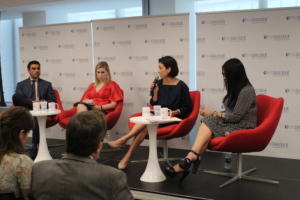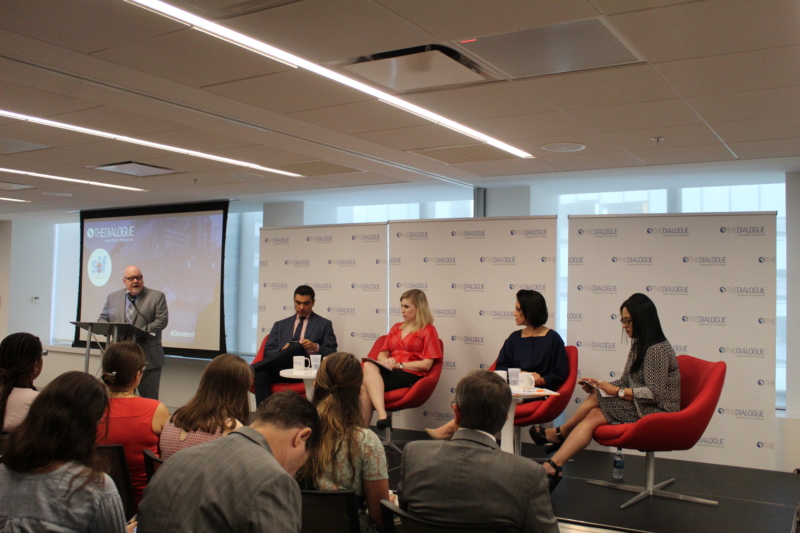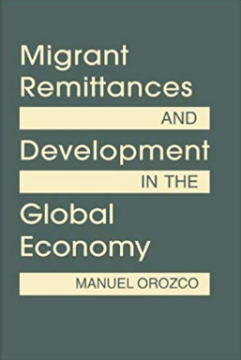What Roles are Women Playing in Mexico’s Drug War?
What roles are women playing in Mexico’s brutal drug trafficking war?
On July 24, the Inter-American Dialogue and the Seattle International Foundation hosted "Nowhere to Turn: Gender-Based Violence and its Impact on Migration." The panel was opened with remarks by Eric Olson, Director of the Central America program at the Seattle International Foundation, and followed by a panel discussion between Corie O'Rourke, Immigration Attorney at Ayuda; Lindsay Jenkins, Protection Officer at the United Nations High Commissioner for Refugees Regional Office for the United States and the Caribbean; and Claudia Maria Izaguirre Mejia, Director of the Young Women's Christian Association (YWCA) in Honduras. The conversation was moderated by Manuel Orozco, Director of the Inter-American Dialogue's Remittances, Migration and Development program.
Olson began by citing some harrowing statistics on gender-based violence in the region: in 2018, 10,367 cases of domestic violence were brought before the Honduran court, or an average of 28 cases per day. Of those, only 30% resulted in some sort of prosecution or sentencing, and the specific information about the kind of sentencing was not disclosed. Furthermore, gender-based violence is almost always under-reported: in 2017 only 75,000 cases of violence against women were reported in a region of 30 million people.
Orozco continued to note that the Northern Triangle is embedded in a history of a culture of violence, with a deep-rooted subordination of women, and there is a strong correlation between migration, especially from high migration areas, and violence against women, particularly in the case of El Salvador. Women in the region are now faced with a triple threat: the problem of a culture of gendered victimization, an ecosystem of organized crime, and a president in the United States who is closing the doors to migration. They have "nowhere to turn."
Izaguirre Mejia attested to the lack of options for women who are victims of violence in Honduras. Not only are women victims of violence at home and in the streets, but they also can’t appeal to government institutions like the Public Ministry because of a dearth of political will or resources. This results in a slightly different triple threat: on the one hand, family, domestic, and sexual violence; compounded by violence on the streets; compounded by a lack of institutional response from the Honduran government. An example of the government's dysfunctional response is that, if a woman brings a complaint to the Public Ministry about experiencing violence, and it issues a restraining order, she herself has to deliver it to her assailant. In this situation, the only recourse becomes seeking asylum in another country.
Jenkins alluded to the larger migration context, stating that the UNHCR is seeing the largest situations of displacement in the region since the 1980s and 90s. Furthermore, since 2014-2015 there have been greater numbers of unaccompanied children fleeing Central America, as well as women alone and with their families. Under international law, someone who has fled violence on the basis of their gender when their country is unable or unwilling to protect them has a valid claim to asylum.
[caption id="attachment_85615" align="alignleft" width="363"] [L to R] Manuel Orozco; Corie O'Rourke; Lindsay Jenkins; Claudia Maria Izaguirre Mejia[/caption]
[L to R] Manuel Orozco; Corie O'Rourke; Lindsay Jenkins; Claudia Maria Izaguirre Mejia[/caption]
However, domestic immigration law does not always gel smoothly with international legal principles. O'Rourke stated that it's always been really difficult for domestic violence or sexual assault survivors to get asylum in the United States, even under the Obama administration, although it is definitely more difficult under Trump. About a year ago, then-Attorney General Jeff Sessions decided “Matter of AB”, which makes it more difficult for survivors of family violence and gang violence to receive status in the United States. As a result, there are some judges that won't even entertain an argument of asylum based on escaping partner violence. However, even those that do often rule against the respondent. Winning these cases is mostly arbitrary, dependent on the region where the case is tried and the character of the judge: some immigration judges have asylum grant rates of 80% while others have grant rates of 2%.
Furthermore, immigration judges often don’t have a background in immigration or any knowledge of the issues affecting the immigrants that come before them: the training they receive is on the laws and procedures. There is a broad under-estimation of how dangerous the situation on the ground is in Central America. And it is bad: O'Rourke said that essentially a hundred percent of her female clients from Central America have been victims of gender-based violence, including those who have been in the United States for 20 years and were affected before they left. However, it is becoming more prevalent, and gangs have been weaponizing rape and impregnating girls and women as a tool of control. Many of O'Rourke's clients have told her that "if there's no blood, the police don't even think about coming," but regardless of any ostensible investigation there is very little will to hold perpetrators accountable, especially if those perpetrators are members of the police, or government officials, or gang members, which many are.
What's more, recent developments in immigration law that are forcing asylum seekers to stay in Mexico while they pursue their case are actually preventing them from accessing justice. Logistically these changes make it so that the respondents have to to show up at the border on the day of their case and try to get let in and try to make it to court in time, and reports from the border are showing that that's not happening. So respondents are being denied the right to present their case. The safe third country agreement signed with Guatemala is ironic because there are also women fleeing Guatemala for reasons of insecurity, and migrant women, in particular, are especially susceptible to violence, so if incoming women are from Honduras and El Salvador they're susceptible to violence at a higher rate than local women in Guatemala and Mexico.
The initial remarks were followed by a question and answer session with the audience.
If the criminal justice systems in these countries were able to hold perpetrators accountable if impunity was reduced for these forms of violence, what effect would that have on the push factors for migration?
O'Rourke: I think one of the fundamental misunderstandings about migration is that it is something people actively want to do: the truth is that people don't want to permanently leave their country. Any improvement in countries of origin in reducing impunity may help stem the flow of migration. However, many women are not able to be economically independent either as a single woman or single mother, so there are reasons beyond lack of police response and lack of accountability for violence that keep women in abusive relationships. Another reason that many women would not want to leave a relationship is because single women and single mothers are at increased risk of attention from gangs because they don't have a man in the house. Reducing impunity is a great first step, but there's a lot more that would need to be done in order for women to truly be able to leave problematic relationships.
What kind of existing programming is there in the region to mitigate femicide and violence against women?
Jenkins: Internationally speaking, there is the MIRPS (Marco Integral Regional de Proteccion y Soluciones) framework led by the UN which has countries in the region - both countries of origin and countries of asylum - coming up with how to make their asylum systems more responsive to to the needs of women and the particular experiences that they've had in their journey as refugees. Within the MIRPS framework there are specific actions that go towards trying to identify the protection needs of women when they're in-country and get them better access to any of the protection mechanisms that exist at a local level and also trying to help countries better understand the dynamics of protection, for instance, having asylum authorities well briefed on identifying these particular issues both in terms of the legal analysis that goes into a claim for asylum based on gender-based violence but all and understanding country of origin conditions.
What's happening to the people who are rejected and returned to Central America? Where do they end up, and what is the recidivism rate, how many are attempting to return to the United States?
O'Rourke: From what I’ve seen in my practice, the people that are able to return again to the United States tend to be men because it's so expensive and it's such a dangerous journey, particularly for women and children. It's also much harder for people that have been deported or voluntarily left to seek relief in the United States again. What’s more, people who arrive back at their home country after having been in the United States are at increased risk of violence and extortion because they are seen as wealthy. For those who were in the United States for a prolonged period of time, it’s also problematic because they have adapted to the American Way of life and have different standards and a different culture, so many times their lives are even more difficult than they were before they left.
Orozco: Reducing impunity for violence wouldn't affect the out-migration process, firstly because you're still not reducing the scale of violence but there are bigger problems that have to do with the social norms that disadvantage women, particularly in terms of economic integration. For example, women in the region are generally less likely to be able to find a formal job than men, leaving them vulnerable. In terms of migrant recidivism, coming to the United States is expensive, but sometimes returned migrants are forced to take the lowest-paying jobs in their home countries, so they are more likely to return once they find the seven thousand dollars it would take to come across.
How do migrants conceptualize being a victim of violence? Among other potential drivers for migration, do they see it as a particular motivation, perhaps relative to economic motivators?
O'Rourke: Many individuals that come to the United States give the “Miss America” answer for why they came to the United States: they say that there are better opportunities here, period. And when people first enter the country and are asked if they’re afraid to go back to their home country -- well, they’ve just been through a very difficult journey, and it’s usually a male Customs and Border Patrol officer, who doesn’t speak great Spanish, asking them; and they’re in detention. It’s a very overwhelming situation, so a lot of people just give fluff answers, even when they first speak to me. However, eventually, I find out that their real reason for fleeing is usually a safety concern, whether it’s gang violence, partner violence, or family violence. Violence is one of the main motivating factors: they were fearful that the violence was turning lethal and so they fled to the United States. Many of my clients don't self-identify as victims of trafficking or victims of violence; avoidance is a coping mechanism for many people, and there's also this idea that domestic violence is allowed and so you don't complain about it; moreover, people don't want to be seen as complaining about their partner out of embarrassment.
Are we seeing creative ways to address the root issues at the local level? And also how could you engage with local governments on addressing gender-based violence?
Izaguirre Mejia: Some local and community initiatives that are taking place in Honduras include, firstly, the municipal police, which is taking initiatives to strengthen prevention of violence against women. Then there are educational initiatives in schools, beginning even in preschools, to try to change the culture of violence in Honduras and instill a culture of respect for different genders, a culture of peace, of positive values, etc. Another initiative is that of community-based policymaking, where we are setting up community tables to bring together actors from civil society, the municipal government, community-based and regional organizations to create policy and strategize on economic issues, issues reduction of gender-based violence, etc.
O'Rourke: Working with local governments is hard when the situation is unstable. For example, in San Salvador, different city blocks are controlled by two gangs, MS-13 and Barrio 18, which basically share custody of the city with the Salvadoran government. So it would be difficult to institute any overarching program when there are three different authorities, and two are criminal gangs.
What roles are women playing in Mexico’s brutal drug trafficking war?
How do patterns of migration and remittances differ across regions? What kinds of frameworks support the contributions of remittances to local development?
Honduras is in the midst of a security crisis, with alarming levels of official corruption and the world’s highest homicide rate.
 Tamar Ziff / Inter-American Dialogue
Tamar Ziff / Inter-American Dialogue

 Video
Video